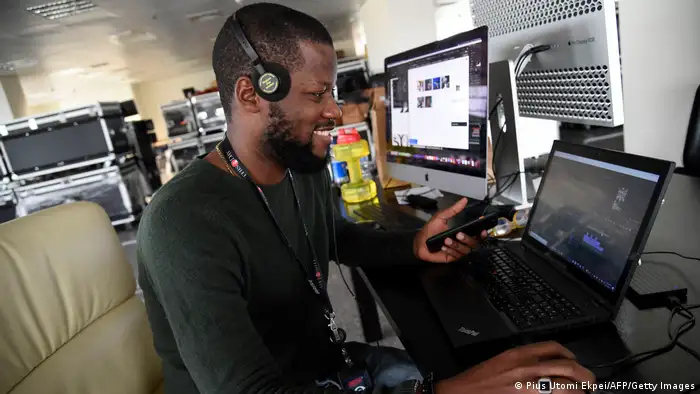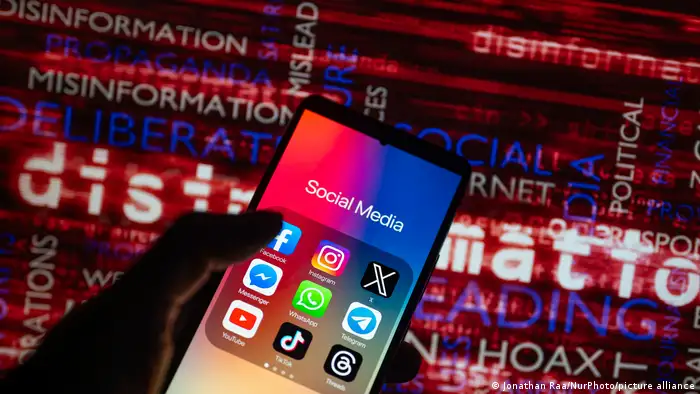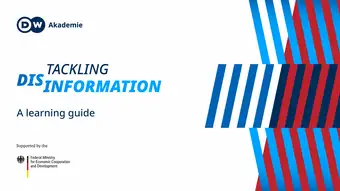Tackling disinformation: A learning guide
Disinformation: Current definitions and examples
While there isn't a universally accepted definitions, here are some of the common ways academics and big tech define disinformation.
Disinformation isn't a new phenomenon. But the scale of the problem has reached a new level in our digital era.
"Digital technology has enabled pathways for false or manipulated information to be created, disseminated and amplified by various actors for political, ideological or commercial motives at a scale, speed and reach never known before," finds UN Special Rapporteur on freedom of opinion and expression, Irene Khan, in a 2021 report.
Also new is the way in which disinformation has become an ideological and inflationary umbrella term that covers a wide range of diverse phenomena, including hate speech, rumors, conspiracy theories, attempts to influence elections, medical misinformation or state propaganda.
Often, the term disinformation is abused by the powerful to discredit those who produce verified information or hold opposing views, including politicians, journalists, human rights activists and scientists.
Politicians can even benefit from an informational environment saturated with misinformation. The concept, known as liar's dividend, posits that public figures and politicians can maintain support by falsely claiming that true events and stories are fake news, deepfakes or simply disinformation.
This conceptual blurring is problematic in many ways, as Khan's report "Disinformation and freedom of opinion and expression" further emphasizes.
"Finding appropriate responses to disinformation is difficult, not least because the concept is undefined and open to abuse, and because the size and nature of the problem is contested in the absence of sufficient data and research. State responses have often been problematic and heavy handed and had a detrimental impact on human rights. Companies play a major role in spreading disinformation, but their efforts to address the problem have been woefully inadequate."
How is disinformation defined?
While there is no definitive universally accepted definition, one of the most influential and comprehensive typologies for the concepts of disinformation, misinformation and malinformation comes from the foundational 2017 report "Information Disorder" by Claire Wardle, today co-director of the Information Futures Lab at Brown University in the US, and media researcher Hossein Derakhshan.
Wardle and Derakhshan speak of a so-called information disorder, which can be described by three types of information:
- Mis-information is when false information is shared, but no harm is meant.
- Dis-information is when false information is knowingly shared to cause harm.
- Mal-information is when genuine information is shared to cause harm, often by moving information designed to stay private into the public sphere.
While definition is has gained enormous traction, in an 2024 interview Wardle told DW Akademie that she is "disappointed" that the definition was people's main take away from the report "because I actually think that the definitional way of thinking about this problem is actually the least interesting and the least useful.
"I've kind of distance myself from those definitions because I think it ... led us down a path that I don't think was as helpful as we needed," she said.
Here are some other definitions of disinformation:
The European Commission understands disinformation "as verifiably false or misleading information that is created, presented and disseminated for economic gain or to intentionally deceive the public, and may cause public harm."
NATO views disinformation as "the deliberate creation and dissemination of false and/or manipulated information with the intent to deceive and/or mislead."
Google acknowledges that disinformation means different things to different people but notes "it is one thing to be wrong about an issue. It is another to purposefully disseminate information one knows to be inaccurate with the hope that others believe it is true or to create discord in society. We refer to these deliberate efforts to deceive and mislead using the speed, scale, and technologies of the open web as "disinformation"."
Facebook has adopted the following definitions:
- Misinformation: refers to misleading content (false news, manipulated content, etc)
- Disinformation: provably false information used by someone who knows it is false
- Influence operation: coordinated effort to manipulate or corrupt public debate for a strategic goal
Why is defining disinformation problematic?
In the case of disinformation, the question of which definition applies has far-reaching political and social implications. That is because a particular definition determines what is categorized as "bad" information, what should be "combated," and how it should be combated.
Designating information as harmful raises further questions, such as who decides which information is harmful and who is harmed by the information.
Then there's the question of how disinformation differs from legitimate political communication, which is protected as freedom of expression but also aims to sway or influence people.
The "fight" against disinformation can quickly become a convenient pretext for curbing fundamental rights, such as the right to freedom of expression or opinion, by silencing unwelcome voices — particularly in states with weak democracies or authoritarian regimes.

Nigeria, where this journalist works, is one of the dozens of countries which has passed laws designed to limit the spread of false or misleading information on social media
According to a 2023 analysis by the Centre for International Media Assistance, 78 countries passed laws between 2011 and 2022 designed to limit the spread of false or misleading information on social media.
While some of these laws focused on improving platform transparency and accountability or increasing media and digital literacy, "many focus on the content itself, criminalizing the creation and distribution of "fake news"," the report found.
"As a result, many misinformation, disinformation, and mal-information (MDM) laws chill press freedom, rather than enhance it."
At the same time, there is a broad consensus that the dissemination of false or misleading information can cause public harm. The influential German-American philosopher Hannah Arendt had the following to say in a 1974 interview about how vital reliable information is for a society:
"... how can you have an opinion if you are not informed? If everybody always lies to you, the consequence is not that you believe the lies, but rather that nobody believes anything any longer. ... And a people that no longer can believe anything cannot make up its mind. It is deprived not only of its capacity to act but also of its capacity to think and to judge. And with such a people you can then do what you please."
The true/false binary can't explain the real world
One of the main criticisms leveled at the terms misinformation and disinformation is the desire to evaluate the content of a message as "true" or "false" or as "good" information versus "harmful" information.
Firstly, as already discussed, there is the question of who gets to decide whether a particular piece of content is false or harmful.
Secondly, it is not always possible to clearly and unambiguously declare individual facts as true or false, especially in the case of opinions that reflect values and attitudes. Even a field such as science, which is often seen as only having a right or wrong answer, is constantly evolving and, at least initially, may elude a binary categorization of true/false.
Disinformation campaigns exploit this uncertainty and capitalize on knowledge gaps and fears about current global events.
In a 2020 report, UNESCO warns of the "balancing act" needed to counter disinformation without stifling freedom of expression.
"For its part, disinformation, by its nature, claims as 'true' not only falsehoods but also often what is the category of the unknown, while frequently seeking to discredit as 'false' that content that has been definitively proven to be true — such as the overwhelming scientific consensus on climate change. It is because of the existence of genuine gray areas, that there are risks in any steps taken to counter disinformation which disregard the large realm of unknowns which exist between proven truth and demonstrated falsehoods. Such measures can stifle legitimate debate and other forms of expression which are needed to help assess the veracity of particular content over time." (Emphasis added by the author)
What about the right to talk nonsense or share silly memes?
It is also important to consider how to deal with (dis)information that doesn't break criminal or civil laws but is obviously wrong. Making incorrect or silly statements — or even outright lying — is protected under freedom of expression, the UNESCO "Balancing Act: Countering Digital Disinformation while respecting Freedom of Expression" report emphasizes.
This means that assuming speech doesn't reach the threshold of legitimate restriction, people have a right to express ill-founded opinions and make non-factual or unsubstantiated statements, the UNECSO report finds. As such, claims such as "the earth is flat" or "it's unseasonably cold so I think global warming is a myth" are protected, including on social media.
It is also important to recognize that the universe of manipulative communication is much broader than disinformation in the sense of false factual claims. Images, memes and satirical allusions are an inseparable part of it. "Conspiracy culture is full of playful references to popular culture, and conspiracy memes are a staple ingredient of today's memetic culture online."
The term disinformation has a certain degree of ambiguity across multiple levels, yet this does not mean we should avoid using it altogether. In fact, the term serves as an effective starting point when addressing broader issues. However, caution is advised in the application of the term, which varies according to the context.
Those employing the term disinformation shouldn't hesitate to highlight its weaknesses and potential pitfalls in discussions about the phenomenon. This caution should be exercised in conversations with partners and donors and within expert discussions to ensure a comprehensive and nuanced understanding of the term.
Foreign Information Manipulation and Interference - a European Union disinformation concept
"Foreign Information Manipulation and Interference (FIMI)describes a mostly non-illegal pattern of behaviour that threatens or has the potential to negatively impact values, procedures and political processes. Such activity is manipulative in character, conducted in an intentional and coordinated manner, by state or non-state actors, including their proxies inside and outside of their own territory."
The term puts emphasis on the manipulative behavior and campaigns in traditional and digital media by foreign actors to undermine democratic values. These behaviors include, for example, the falsification of user accounts in social media or the artificial amplification of reach. In its first comprehensive report of FIMI the EEAS identified and analyzed around 100 FIMI incidents between October and December 2022. The report identifies Russia as a central actor.
"Disinformation and propaganda outlets are today a weapon of the Kremlin. And this weapon is a weapon – it hurts, it kills. It kills the capacity of the people of understanding what is going on, and, as a consequence, the position of governments and the decisions of international organisations. " said the EU’s chief diplomat, Josep Borrell in his speechon the publication of the report.
In this video Sébastian Babaud from the Sub-Saharan Africa Task Force at EEAS explains the concept of FIMI and its importance for the media sector.
Recommended reading
In their excellent post, Vera Tolz and Stephen Hutchings of the University of Manchester reflect on the history of the term disinformation and what initiatives to counter disinformation today can learn from the term's usage over the years.
This article is part of Tackling Disinformation: A Learning Guide produced by DW Akademie.
The Learning Guide includes explainers, videos and articles aimed at helping those already working in the field or directly impacted by the issues, such as media professionals, civil society actors, DW Akademie partners and experts.
It offers insights for evaluating media development activities and rethinking approaches to disinformation, alongside practical solutions and expert advice, with a focus on the Global South and Eastern Europe.
DW recommends
- Date 12.04.2024
- Author Steffen Leidel
- Feedback: Send us your feedback.
- Print Print this page
- Permalink https://p.dw.com/p/4aQTI
- Date 12.04.2024
- Author Steffen Leidel
- Send us your feedback.
- Print Print this page
- Permalink https://p.dw.com/p/4aQTI


